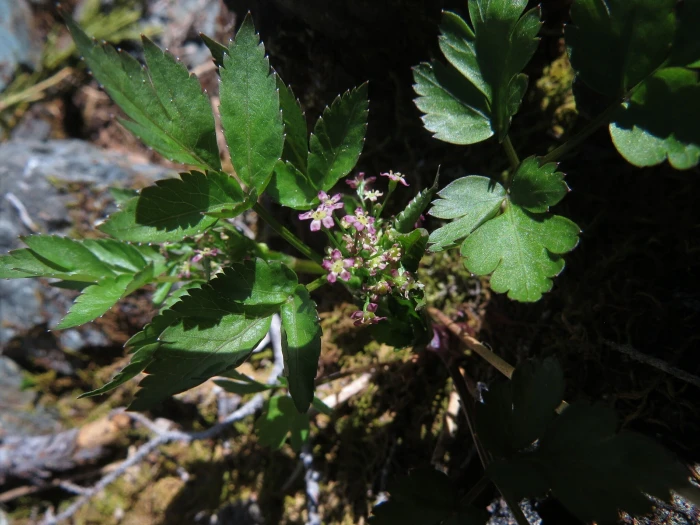Purple Sweetroot
(Osmorhiza purpurea)
Purple Sweetroot (Osmorhiza purpurea)
/
/

Jack Bindernagel
CC BY 4.0
Image By:
Jack Bindernagel
Recorded By:
Copyright:
CC BY 4.0
Copyright Notice:
Photo by: Jack Bindernagel | License Type: CC BY 4.0 | License URL: http://creativecommons.org/licenses/by/4.0/ | Rights Holder: Jack Bindernagel | Publisher: iNaturalist | Date Created: 2022-07-28T03:57:45-07:00 |

















Estimated Native Range
Climate Requirements
| • Precipitation | 58" - 69" |
| • High Temp. | 61°F - 81°F |
| • Low Temp. | 8°F - 32°F |
Summary
Osmorhiza purpurea, commonly known as Purple Sweetroot, Purple Sweet Cicely, or Alpine Sweet Cicely, is a perennial herb native to the understory of montane forests, subalpine meadows, and streambanks in Western North America. It typically grows to a height of 1.5-3 feet (0.46-0.9 meters) and features compound leaves with a deep green color and a fern-like appearance. The plant produces clusters of small, white flowers in the spring, which are not particularly showy but have a sweet fragrance. The flowers give way to elongated, purple-tinged seed pods that add visual interest in the summer months.
Purple Sweetroot is valued for its aromatic foliage and roots, which have a sweet, anise-like scent. It is often used in woodland gardens, naturalized areas, and as a component of shade gardens due to its adaptability to lower light conditions. This herb is relatively low-maintenance, requiring medium water and thriving in well-drained loam soils with rich organic matter. While it is not prone to serious pest or disease problems, it can be susceptible to root rot in overly wet conditions. Additionally, it is appreciated for its historical use in traditional medicine and as a flavoring agent in culinary applications.CC BY-SA 4.0
Purple Sweetroot is valued for its aromatic foliage and roots, which have a sweet, anise-like scent. It is often used in woodland gardens, naturalized areas, and as a component of shade gardens due to its adaptability to lower light conditions. This herb is relatively low-maintenance, requiring medium water and thriving in well-drained loam soils with rich organic matter. While it is not prone to serious pest or disease problems, it can be susceptible to root rot in overly wet conditions. Additionally, it is appreciated for its historical use in traditional medicine and as a flavoring agent in culinary applications.CC BY-SA 4.0
Plant Description
- Plant Type: Herb
- Height: 1.5-3 feet
- Width: 1-2 feet
- Growth Rate: Moderate
- Flower Color: Pink, Purple, White
- Flowering Season: Summer
- Leaf Retention: Deciduous
Growth Requirements
- Sun: Part Shade, Full Shade
- Water: Medium
- Drainage: Medium
Common Uses
Bee Garden, Butterfly Garden, Low Maintenance
Natural Habitat
Montane forests, subalpine meadows, and streambanks in Western North America
Other Names
Common Names: Purple Sweet Cicely, Alpine Sweet Cicely
Scientific Names: Osmorhiza purpurea, Osmorhiza chilensis var. purpurea, Osmorhiza leibergii, Osmorhiza leibergii, Washingtonia leibergii, Washingtonia purpurea
GBIF Accepted Name: Osmorhiza purpurea